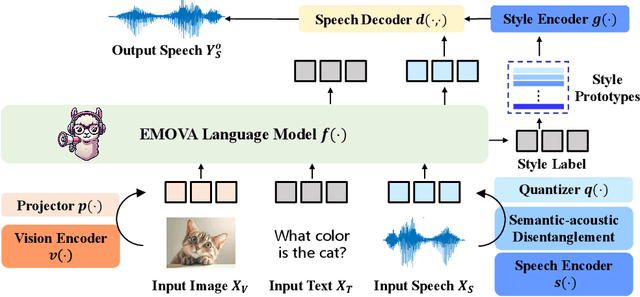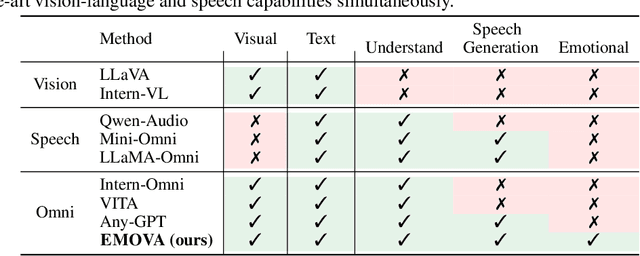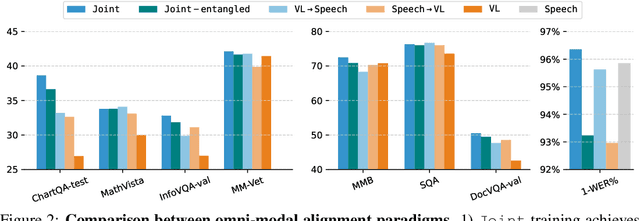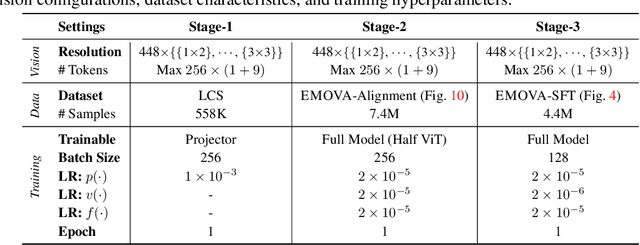Weike Jin
Unifying Multimodal Large Language Model Capabilities and Modalities via Model Merging
May 26, 2025Abstract:While foundation models update slowly due to resource-intensive training requirements, domain-specific models evolve between updates. Model merging aims to combine multiple expert models into a single, more capable model, thereby reducing storage and serving costs while supporting decentralized model development. Despite its potential, previous studies have primarily focused on merging visual classification models or Large Language Models (LLMs) for code and math tasks. Multimodal Large Language Models (MLLMs), which extend the capabilities of LLMs through large-scale multimodal training, have gained traction. However, there lacks a benchmark for model merging research that clearly divides the tasks for MLLM training and evaluation. In this paper, (i) we introduce the model merging benchmark for MLLMs, which includes multiple tasks such as VQA, Geometry, Chart, OCR, and Grounding, providing both LoRA and full fine-tuning models. Moreover, we explore how model merging can combine different modalities (e.g., vision-language, audio-language, and video-language models), moving toward the Omni-language model. (ii) We implement 10 model merging algorithms on the benchmark. Furthermore, we propose a novel method that removes noise from task vectors and robustly optimizes the merged vector based on a loss defined over task vector interactions, achieving an average performance gain of 2.48%. (iii) We find that model merging offers a promising way for building improved MLLMs without requiring data training. Our results also demonstrate that the complementarity among multiple modalities outperforms individual modalities.
EMOVA: Empowering Language Models to See, Hear and Speak with Vivid Emotions
Sep 26, 2024



Abstract:GPT-4o, an omni-modal model that enables vocal conversations with diverse emotions and tones, marks a milestone for omni-modal foundation models. However, empowering Large Language Models to perceive and generate images, texts, and speeches end-to-end with publicly available data remains challenging in the open-source community. Existing vision-language models rely on external tools for the speech processing, while speech-language models still suffer from limited or even without vision-understanding abilities. To address this gap, we propose EMOVA (EMotionally Omni-present Voice Assistant), to enable Large Language Models with end-to-end speech capabilities while maintaining the leading vision-language performance. With a semantic-acoustic disentangled speech tokenizer, we notice surprisingly that omni-modal alignment can further enhance vision-language and speech abilities compared with the corresponding bi-modal aligned counterparts. Moreover, a lightweight style module is proposed for flexible speech style controls (e.g., emotions and pitches). For the first time, EMOVA achieves state-of-the-art performance on both the vision-language and speech benchmarks, and meanwhile, supporting omni-modal spoken dialogue with vivid emotions.
Gloss Attention for Gloss-free Sign Language Translation
Jul 14, 2023Abstract:Most sign language translation (SLT) methods to date require the use of gloss annotations to provide additional supervision information, however, the acquisition of gloss is not easy. To solve this problem, we first perform an analysis of existing models to confirm how gloss annotations make SLT easier. We find that it can provide two aspects of information for the model, 1) it can help the model implicitly learn the location of semantic boundaries in continuous sign language videos, 2) it can help the model understand the sign language video globally. We then propose \emph{gloss attention}, which enables the model to keep its attention within video segments that have the same semantics locally, just as gloss helps existing models do. Furthermore, we transfer the knowledge of sentence-to-sentence similarity from the natural language model to our gloss attention SLT network (GASLT) to help it understand sign language videos at the sentence level. Experimental results on multiple large-scale sign language datasets show that our proposed GASLT model significantly outperforms existing methods. Our code is provided in \url{https://github.com/YinAoXiong/GASLT}.
Frame-Subtitle Self-Supervision for Multi-Modal Video Question Answering
Sep 08, 2022



Abstract:Multi-modal video question answering aims to predict correct answer and localize the temporal boundary relevant to the question. The temporal annotations of questions improve QA performance and interpretability of recent works, but they are usually empirical and costly. To avoid the temporal annotations, we devise a weakly supervised question grounding (WSQG) setting, where only QA annotations are used and the relevant temporal boundaries are generated according to the temporal attention scores. To substitute the temporal annotations, we transform the correspondence between frames and subtitles to Frame-Subtitle (FS) self-supervision, which helps to optimize the temporal attention scores and hence improve the video-language understanding in VideoQA model. The extensive experiments on TVQA and TVQA+ datasets demonstrate that the proposed WSQG strategy gets comparable performance on question grounding, and the FS self-supervision helps improve the question answering and grounding performance on both QA-supervision only and full-supervision settings.
VLAD-VSA: Cross-Domain Face Presentation Attack Detection with Vocabulary Separation and Adaptation
Feb 21, 2022



Abstract:For face presentation attack detection (PAD), most of the spoofing cues are subtle, local image patterns (e.g., local image distortion, 3D mask edge and cut photo edges). The representations of existing PAD works with simple global pooling method, however, lose the local feature discriminability. In this paper, the VLAD aggregation method is adopted to quantize local features with visual vocabulary locally partitioning the feature space, and hence preserve the local discriminability. We further propose the vocabulary separation and adaptation method to modify VLAD for cross-domain PADtask. The proposed vocabulary separation method divides vocabulary into domain-shared and domain-specific visual words to cope with the diversity of live and attack faces under the cross-domain scenario. The proposed vocabulary adaptation method imitates the maximization step of the k-means algorithm in the end-to-end training, which guarantees the visual words be close to the center of assigned local features and thus brings robust similarity measurement. We give illustrations and extensive experiments to demonstrate the effectiveness of VLAD with the proposed vocabulary separation and adaptation method on standard cross-domain PAD benchmarks. The codes are available at https://github.com/Liubinggunzu/VLAD-VSA.
SimulSLT: End-to-End Simultaneous Sign Language Translation
Dec 08, 2021



Abstract:Sign language translation as a kind of technology with profound social significance has attracted growing researchers' interest in recent years. However, the existing sign language translation methods need to read all the videos before starting the translation, which leads to a high inference latency and also limits their application in real-life scenarios. To solve this problem, we propose SimulSLT, the first end-to-end simultaneous sign language translation model, which can translate sign language videos into target text concurrently. SimulSLT is composed of a text decoder, a boundary predictor, and a masked encoder. We 1) use the wait-k strategy for simultaneous translation. 2) design a novel boundary predictor based on the integrate-and-fire module to output the gloss boundary, which is used to model the correspondence between the sign language video and the gloss. 3) propose an innovative re-encode method to help the model obtain more abundant contextual information, which allows the existing video features to interact fully. The experimental results conducted on the RWTH-PHOENIX-Weather 2014T dataset show that SimulSLT achieves BLEU scores that exceed the latest end-to-end non-simultaneous sign language translation model while maintaining low latency, which proves the effectiveness of our method.
 Add to Chrome
Add to Chrome Add to Firefox
Add to Firefox Add to Edge
Add to Edge